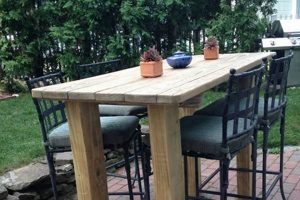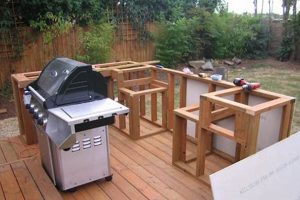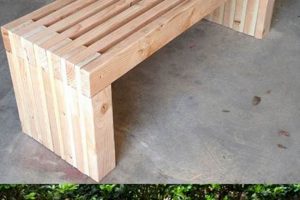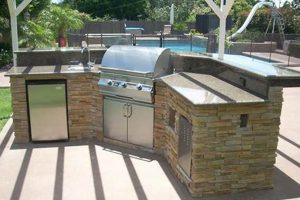A self-constructed support structure intended for mounting an exterior water spigot defines a do-it-yourself project of this nature. Typically, it involves assembling or building a sturdy vertical element from materials such as wood, metal, or composite lumber. This structure then serves as the anchor point for the plumbing fixture, allowing for convenient access to water in an outdoor setting. An example would be crafting a pressure-treated timber post to which an anti-freeze hose bib is securely attached, situated near a garden or landscaping area.
The significance of establishing a reliable and aesthetically pleasing outdoor water source is multi-faceted. It provides convenience for tasks such as gardening, washing vehicles, and filling pools. Furthermore, properly designed and executed outdoor faucet installations can increase property value and improve the overall functionality of exterior spaces. The concept of an outdoor water source has evolved from simple well access to sophisticated plumbing systems integrated seamlessly into landscape design.
The subsequent sections will elaborate on the design considerations, material selection, construction techniques, and plumbing connections inherent in undertaking the creation of a personalized, self-assembled exterior water access point.
Essential Considerations for a Self-Constructed Exterior Spigot Support
The following recommendations are provided to ensure a structurally sound, aesthetically pleasing, and functionally reliable outcome when building a support for an outdoor water outlet.
Tip 1: Material Selection: Prioritize materials resistant to environmental degradation. Pressure-treated lumber, composite materials, or powder-coated metal offer enhanced durability against moisture, insects, and UV exposure. The choice should align with the climate and anticipated usage.
Tip 2: Frost Protection: In regions subject to freezing temperatures, incorporate frost-resistant hose bibs and consider insulating the water supply lines within the support structure. This minimizes the risk of burst pipes and water damage during winter months.
Tip 3: Structural Integrity: Ensure the post is adequately anchored to the ground. Concrete footing is preferable for stability, particularly in areas prone to high winds or soil erosion. The depth of the footing should be below the local frost line.
Tip 4: Plumbing Connections: Employ proper plumbing techniques when connecting the spigot to the water supply. Use appropriate fittings, pipe sealant, and pressure testing to prevent leaks and ensure a watertight seal.
Tip 5: Drainage Considerations: Implement a drainage system to divert water away from the base of the post. This prevents soil erosion and minimizes the risk of water damage to surrounding structures.
Tip 6: Aesthetic Integration: Design the support to complement the surrounding landscape. Consider the style, color, and texture of the materials to create a visually appealing addition to the outdoor space.
Tip 7: Accessibility and Ergonomics: Position the spigot at a comfortable height and location for convenient use. Consider the reach and mobility of the intended users.
Adhering to these guidelines will contribute to the construction of a durable, functional, and aesthetically pleasing element that enhances the utility and value of the outdoor environment.
The subsequent section will delve into common challenges and troubleshooting techniques encountered during the construction process.
1. Durability
Durability, in the context of a self-constructed exterior water spigot support, is a critical factor that dictates the structure’s lifespan and long-term performance. It encompasses the ability to withstand environmental stressors, physical wear, and prolonged exposure to the elements. Failure to adequately address durability concerns can result in structural compromise, increased maintenance requirements, and premature failure of the installation.
- Material Selection and Resistance to Environmental Degradation
The choice of materials directly impacts the structure’s ability to resist rot, corrosion, and UV damage. Pressure-treated lumber, for example, offers enhanced protection against fungal decay and insect infestation compared to untreated wood. Similarly, powder-coated metal provides superior resistance to rust and corrosion compared to untreated steel. The selection should correspond to the local climate and anticipated environmental conditions. Neglecting this aspect can lead to rapid deterioration and structural failure. For example, using untreated wood in a consistently damp environment will necessitate frequent repairs or complete replacement.
- Structural Integrity and Load-Bearing Capacity
The support structure must be capable of withstanding the weight of the spigot, attached hoses, and any applied external forces, such as wind or accidental impacts. The design and construction techniques employed should ensure adequate load-bearing capacity and resistance to deformation. This necessitates the use of appropriate fasteners, bracing, and anchoring methods. For example, inadequate anchoring or insufficient bracing can lead to instability and potential collapse, particularly under heavy loads or during inclement weather.
- Resistance to Freeze-Thaw Cycles
In regions subject to freezing temperatures, the support structure must be designed to withstand the expansion and contraction forces associated with freeze-thaw cycles. This includes selecting materials that are resistant to cracking and spalling and incorporating design features that minimize water accumulation and promote drainage. Failure to address this can result in structural damage and premature failure. An example of this is using concrete that is not properly air-entrained. It can crack and crumble after repeated freeze thaw cycles.
- Protection Against Physical Wear and Impact
The location and design of the support structure should consider the potential for physical wear and impact from accidental contact with vehicles, lawnmowers, or other equipment. Protective measures, such as bollards or strategically placed landscaping, can help to minimize the risk of damage. A well-designed installation should be robust enough to withstand minor impacts without compromising its structural integrity. For example, placing the post behind a low wall or landscaping feature provides physical protection against accidental damage.
The facets outlined above collectively contribute to the overall durability of a self-assembled exterior water spigot support. A holistic approach that considers material selection, structural design, environmental factors, and potential physical wear is essential for creating a long-lasting and reliable installation. Careful planning and meticulous execution will minimize maintenance requirements and maximize the lifespan of the structure, ultimately delivering a cost-effective and sustainable solution.
2. Stability
Stability is a paramount consideration in the successful construction of a self-assembled exterior water spigot support. It directly influences the structural integrity, safety, and longevity of the installation. An unstable support can lead to spigot damage, plumbing leaks, and potential hazards. The following examines crucial aspects of stability in the context of this type of project.
- Foundation and Anchoring
The foundation serves as the primary interface between the support post and the ground. Proper foundation design and anchoring are critical for resisting lateral forces from wind, soil movement, and applied loads. Options include concrete footings, driven posts, or ground anchors. The choice depends on soil conditions, frost depth, and local building codes. For example, in areas with expansive clay soils, a deeper and wider concrete footing is necessary to prevent shifting due to soil heaving. Inadequate anchoring can lead to tilting, settling, or complete failure of the support structure.
- Post Material and Dimensions
The material and dimensions of the support post contribute significantly to its overall stability. Stronger and more rigid materials, such as steel or thick lumber, provide greater resistance to bending and deflection under load. The height and cross-sectional dimensions of the post should be carefully calculated to ensure adequate stability. For instance, a taller post requires a larger cross-section to prevent buckling under wind loads. Using an undersized post can result in excessive flexing, which can damage the spigot and plumbing connections.
- Bracing and Support Elements
The integration of bracing and support elements enhances stability by distributing loads and preventing movement. Diagonal bracing, horizontal supports, or attachment to existing structures can increase the overall rigidity of the assembly. The strategic placement of these elements is crucial for maximizing their effectiveness. For example, diagonal bracing attached to the post and foundation provides increased resistance to lateral forces. The absence of adequate bracing can lead to wobbling and instability, particularly in exposed locations.
- Soil Type and Compaction
The nature of the soil surrounding the post directly affects its stability. Loose, unconsolidated soils provide less support than well-compacted or rocky soils. Prior to installation, the soil should be compacted to increase its bearing capacity. In areas with unstable soils, soil stabilization techniques, such as adding gravel or using soil compaction equipment, may be necessary. Planting a post directly into loose soil leads to settling and tilting over time, compromising the structural integrity.
These factors illustrate the interconnectedness of stability and the overall success of a self-constructed exterior water spigot support. A thorough evaluation of these aspects during the planning and construction phases is essential to ensure a secure, reliable, and long-lasting installation. A stable structure not only enhances the functional utility of the spigot but also mitigates the risk of property damage and potential injury.
3. Weather Resistance
Weather resistance is a critical determinant of the lifespan and functionality of any self-constructed exterior water spigot support. Given its constant exposure to the elements, the structure must be designed and built to withstand a range of environmental stressors to ensure long-term reliability.
- Material Selection and Environmental Suitability
The choice of materials dictates the support’s ability to resist degradation caused by moisture, UV radiation, temperature fluctuations, and biological agents. Pressure-treated lumber, composite materials, and corrosion-resistant metals are common choices due to their inherent weather-resistant properties. For instance, using untreated wood in a humid environment will accelerate rot and decay, necessitating frequent repairs. Selecting appropriate materials for the specific climate is paramount for maximizing the structure’s lifespan.
- Protective Coatings and Sealants
The application of protective coatings and sealants provides an additional layer of defense against the elements. Paints, stains, and waterproofing compounds shield the underlying materials from moisture penetration, UV damage, and biological growth. Regular maintenance and reapplication of these coatings are essential for maintaining their effectiveness. Neglecting to seal exposed wood surfaces can lead to water absorption and subsequent warping, cracking, or rotting. The selection of coatings should be compatible with the chosen materials and the anticipated environmental conditions.
- Design for Water Management and Drainage
The design of the support should incorporate features that facilitate water runoff and prevent water accumulation. Sloped surfaces, drainage channels, and proper ventilation minimize the risk of moisture-related damage. For example, ensuring that the base of the post is elevated above ground level prevents water from pooling and accelerating rot. The design should also consider the direction of prevailing winds and rainfall to minimize exposure to the elements. Proper water management is crucial for preventing structural damage and maintaining the aesthetic appearance of the installation.
- Frost Protection and Freeze-Thaw Resistance
In regions subject to freezing temperatures, the support structure must be designed to withstand the expansion and contraction forces associated with freeze-thaw cycles. The use of frost-resistant materials, insulation, and proper drainage minimizes the risk of cracking, spalling, and other forms of damage. Insulating water pipes within the post is essential to prevent freezing and bursting. Ignoring frost protection measures can lead to costly repairs and disruptions in water service during the winter months.
The considerations presented above underscore the critical role of weather resistance in the successful implementation of a self-constructed exterior water spigot support. A holistic approach that addresses material selection, protective measures, design considerations, and frost protection ensures a durable, reliable, and aesthetically pleasing installation that withstands the rigors of the outdoor environment for years to come. A well-protected structure minimizes maintenance requirements and maximizes the value and functionality of the outdoor space.
4. Accessibility
Accessibility, when considered in the context of a self-constructed exterior water spigot support, directly relates to the ease and convenience with which individuals can utilize the water source. The design and placement of the structure should prioritize usability for all intended users, accommodating diverse needs and abilities.
- Height and Reach Considerations
The height of the spigot and the surrounding operating mechanisms (e.g., handle) should be positioned at a comfortable level to minimize bending or stretching. This is particularly relevant for individuals with limited mobility or back problems. For example, a spigot mounted too low may require excessive bending, while one mounted too high may be difficult to reach for shorter individuals. The placement should align with common ergonomic principles to promote ease of use and reduce strain.
- Clearance and Maneuverability
Sufficient clear space around the support structure is essential for easy access, especially for those using mobility aids like wheelchairs or walkers. This involves ensuring adequate turning radius and unobstructed pathways leading to the spigot. For instance, a narrow walkway or cluttered landscape may impede access for individuals with mobility limitations. The surrounding area should be free of obstacles that could hinder maneuverability and increase the risk of accidents.
- Control Mechanisms and Operability
The spigot’s control mechanism (e.g., handle, lever) should be easy to grip and operate, requiring minimal force or dexterity. Lever handles, for instance, are often preferred over traditional knob-style handles as they require less gripping strength. The design should accommodate individuals with arthritis or other conditions that limit hand strength and dexterity. Control mechanisms should also be clearly labeled and intuitive to use, even for unfamiliar users.
- Visibility and Identification
The support structure and the spigot itself should be easily visible and identifiable, especially at night or in low-light conditions. This involves the use of contrasting colors, reflective materials, or adequate lighting. For example, a dark-colored spigot mounted against a similarly colored background may be difficult to locate, especially for individuals with visual impairments. Proper visibility enhances safety and ease of use, preventing accidental bumps or misidentification.
The accessibility aspects highlighted above collectively contribute to a more user-friendly and inclusive self-constructed exterior water spigot support. By addressing height and reach considerations, ensuring adequate clearance, utilizing easy-to-operate control mechanisms, and prioritizing visibility, the structure can be made accessible to a wider range of users, enhancing its overall utility and value. Prioritizing universal design principles in the construction process promotes inclusivity and ensures that the water source can be readily accessed and utilized by all members of the community.
5. Plumbing Integrity
Plumbing integrity constitutes a fundamental element in the successful execution and long-term functionality of a self-constructed exterior water spigot support. It encompasses the leak-proof nature, structural soundness, and code compliance of all plumbing connections involved in delivering water to the outdoor faucet. The absence of plumbing integrity directly compromises the entire installation, leading to water wastage, property damage, and potential health hazards. For example, poorly sealed threaded connections invariably result in water leakage, which, over time, can erode the support structure’s foundation and foster mold growth. Neglecting proper plumbing practices can transform a convenient water source into a liability. A structurally compromised plumbing system introduces the potential for catastrophic failure, particularly during periods of freezing temperatures when water expands within the pipes. This expansion can cause pipes to burst, resulting in significant water damage to surrounding structures.
Properly executed plumbing practices during the installation process significantly affect the water spigot support’s usability and longevity. Employing appropriate pipe sealants, using correct fitting types for the pipe material, and ensuring secure connections are all paramount. The use of Teflon tape or pipe dope on threaded joints, combined with adequate tightening, creates a watertight seal. Furthermore, adherence to local plumbing codes is non-negotiable. These codes dictate specific requirements for pipe materials, installation techniques, and backflow prevention measures to safeguard the potable water supply. A common issue arises when dissimilar metals are directly connected in the plumbing system, leading to galvanic corrosion and eventual failure. Employing dielectric unions in such instances mitigates this risk, preserving the system’s integrity over time.
In conclusion, plumbing integrity is not merely a desirable attribute but an indispensable requirement for a successfully constructed and functioning outdoor water spigot support. Failure to prioritize sound plumbing practices results in a compromised installation prone to leaks, damage, and potential health hazards. Adherence to proper techniques, code compliance, and the use of appropriate materials are essential to ensure a durable, reliable, and safe outdoor water source. The practical significance lies in minimizing water wastage, preventing property damage, and ensuring access to potable water for the long term.
Frequently Asked Questions About Exterior Spigot Support Structures
This section addresses common inquiries regarding the planning, construction, and maintenance of self-assembled exterior water spigot supports, providing concise and informative answers to ensure a durable and functional installation.
Question 1: What materials are most suitable for constructing a long-lasting water spigot post?
Pressure-treated lumber, composite lumber, and powder-coated metal are recognized for their resistance to rot, insect infestation, and corrosion. The optimal material depends on specific environmental conditions and aesthetic preferences. Untreated wood is not recommended due to its susceptibility to decay.
Question 2: How deep should the foundation be for a water spigot post in a region with freezing temperatures?
The foundation depth must extend below the local frost line to prevent heaving and instability caused by freeze-thaw cycles. Consult local building codes for specific frost depth requirements in the region. A general guideline is a minimum depth of 36 inches in colder climates.
Question 3: Is it necessary to insulate the water supply lines within the spigot post?
In areas with freezing temperatures, insulating the water supply lines is highly recommended to prevent pipes from freezing and bursting. Pipe insulation sleeves or heat tape can provide adequate protection. Additionally, using a frost-free hose bib helps prevent water from freezing within the faucet itself.
Question 4: What are the recommended techniques for ensuring a leak-proof plumbing connection to the spigot?
Employ Teflon tape or pipe dope on all threaded connections to create a watertight seal. Ensure that fittings are properly tightened, but avoid over-tightening, which can damage the threads. Pressure test the connections after installation to identify and address any leaks before backfilling the area.
Question 5: How can the aesthetic appeal of a water spigot post be enhanced to complement the surrounding landscape?
Consider the style, color, and texture of the materials used to build the post. Incorporate decorative elements, such as trim, paint, or climbing plants, to integrate the structure seamlessly into the landscape design. Matching the style of the post to existing architectural features can also enhance visual harmony.
Question 6: What measures should be taken to prevent water from pooling around the base of the spigot post?
Ensure that the surrounding ground slopes away from the base of the post to promote water runoff. Install a gravel drainage bed around the base to facilitate water absorption. Consider incorporating a small drainage pipe to direct excess water away from the immediate area.
These FAQs provide essential information to facilitate the successful construction of a functional and aesthetically pleasing water spigot support. Attention to detail and adherence to sound building practices are crucial for ensuring a durable and reliable installation.
The following section provides a detailed guide to constructing a basic, yet effective, exterior spigot support.
diy outdoor faucet post
The foregoing analysis has elucidated the multifaceted considerations inherent in a self-constructed exterior water spigot support. From material selection and foundation stability to weather resistance, accessibility, and plumbing integrity, each element contributes critically to the structure’s overall functionality and longevity. The omission of due diligence in any of these areas can result in a compromised installation, leading to premature failure and potential property damage.
Therefore, meticulous planning and adherence to sound construction principles are paramount. This ensures a durable, reliable, and aesthetically integrated exterior water source. Careful execution delivers long-term utility and enhances the value of the property. This pursuit is best accomplished by thorough research, judicious material selection, and unwavering attention to detail throughout the building process.







